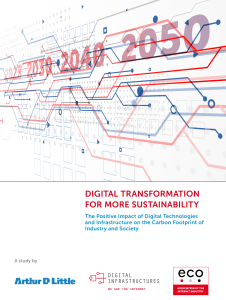eco Chair of the Board Oliver Süme: “Sustainability and digitalisation are two sides of the same coin – digital technologies and applications are part of the solution to achieve climate goals.”
- The study by eco and Arthur D. Little examines effects of digital transformation on resource efficiency and CO2 emissions in the Industrial, Urban and Rural sectors
- Use of digitalisation levers in these sectors will enable CO2 savings of 163 Mt by 2050
- An additional 104 Mt lower level of emissions is forecast for the latest technologies for data storage and transmission
- Expansion of high-performance digital infrastructures is essential to realise the predicted CO2 savings potentials
In order to achieve the German federal government’s climate goals and climate neutrality in line with the Paris Agreement for 2050, digital infrastructures as well as digital services and technologies are an indispensable part of the solution. This is shown by a study now published by eco – Association of the Internet Industry in cooperation with Arthur D. Little and the Alliance for the Strengthening of Digital Infrastructures in Germany, which was founded under the umbrella of eco.
The study forecasts CO2 emissions for Germany in 2050 and compares them to the potential CO2 savings to be achieved through the consistent introduction and use of digital technologies and services in the Industrial, Urban (city) and Rural (rural living and farming) sectors. According to the study, digitalisation levers in these sectors will together enable CO2 savings of 163 megatonnes by 2050. This corresponds to around 20 per cent of the total emissions forecast for Germany in 2050. For the data storage and transmission sector, an additional savings potential of 104 megatonnes is forecast, so that a total reduction in CO2 emissions of 30 per cent would be possible by 2050.
“European policymakers must see digitalisation and sustainability as two sides of the same coin and promote the potential of the Internet industry for achieving sustainability goals accordingly, utilising it in close exchange with the industry,” urges Oliver Süme, Chair of the Board of the eco Association. A significantly better CO2 balance is achievable in many sectors thanks to digital technologies and applications – especially through Internet of Things (IoT) application scenarios. It is the responsibility of policymakers to now develop holistic and consistent concepts in close exchange with the industry in order to fully harness this potential for a sustainable digital future.
In particular, a rapid roll-out of connected mobility and a strengthening of Europe as a technology location via innovative technologies and applications – such as artificial intelligence and the high-performance ecosystem of digital infrastructures – will have a positive impact on sustainability and climate protection goals in the medium term.
Digital technologies are key to CO2 savings
According to the ADL Sustainability Model, the consistent use of digitalisation levers can reduce Germany’s projected 2050 CO2 emissions by around 98 megatonnes in the Industry sector, while 43 megatonnes are possible in the Urban sector and 22 megatonnes in the Rural sector. “From smart meters that continuously monitor energy consumption to smart parking or waste management systems, there are countless ways to use technological innovations that have a huge positive impact on the carbon footprint,” says Lars Riegel, co-author of the study and Head of TMT PE & Infrastructure at Arthur D. Little. “Digital infrastructures and data centres in particular do consume energy: but in so doing, they contribute significantly more to our positive carbon footprint than their degree of consummation!”
With the help of connected mobility solutions alone, the volume of CO2 emissions in Germany could be reduced by 14 megatonnes by 2030, which is roughly 20 per cent of the transport emissions forecast for 2050. Rising emissions in Urban sectors could also be counteracted by holistic smart city concepts: savings of 80,000 tonnes of CO2 per day are possible here by 2030. For the Rural and Industrial sectors, the digital transformation also indicates a significant reduction in CO2 emission projections. For example, IoT applications would reduce industrial CO2 emissions by 37 per cent by 2050. Rural emissions can be reduced by 39 per cent by 2050 through digital innovations.
Ecosystem of digital infrastructures is prerequisite for achieving climate goals
“In order to leverage the predicted CO2 savings potential, the roll-out of an efficient ecosystem of digital infrastructures is essential. This starts with a consistent fibre-optic expansion via the nationwide deployment of 5G technologies for mobile Internet utilisation and also focuses on the migration to the cloud of data previously stored in small business servers. High-performance data centres form the backbone of digitalisation in Germany and make all the technological applications in numerous areas of business and life possible that have a positive impact on Germany’s and Europe’s carbon footprint,” says Béla Waldhauser, Spokesperson for the Alliance for the Strengthening of Digital Infrastructures in Germany, which was founded under the umbrella of the eco Association.
Already today, the eco-balance of digitalisation is already proving to be positive. Energy efficiency has always been in the economic interest of data centre operators. The CO2 emissions of European data centres have therefore been declining since 2015. Today, they require 12 times less energy per workload than in 2010.
However, the creation of a sustainable digital ecosystem requires the participation of all relevant stakeholders. Policymakers in particular are therefore called upon to establish the necessary framework conditions and competitive factors that enable sustainable transformation while strengthening Germany as a digital location. This requires, in particular, greater availability of renewable energies for the operation of digital infrastructures and corresponding applications on a sufficient scale and at economic conditions.
The complete study “Digital Transformation for More Sustainability: The Positive Impact of Digital Technologies and Infrastructure on the Carbon Footprint of Industry and Society” by Arthur D. Little on behalf of eco is available for download free of charge.
The eco initiative “#JOINTHESOLUTION: We are part of the solution – the Internet industry” illustrates further positive impact potentials of digitalisation on carbon footprint, resource efficiency and sustainability goals.




